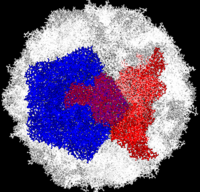ANTIVIRAL ACTIVITY of 3(2H)- and 6-CHLORO-3(2H)-ISOFLAVENES AGAINST HIGHLY DIVERGED, NEUROVIRULENT VACCINE-DERIVED, TYPE 2 POLIOVIRUS SEWAGE ISOLATES
Lester M. Shulman, Danit Sofer, Yossi Manor, Ella Mendelson, Jean Balanant, Anna Laura Salvati, Francis Delpeyroux, Lucia Fiore[1]
Molecular Tour

Complete Poliovirus 2 Viron based on PDB entry
1eah,
example of 3-fold symmetry is in red,
example of 5-fold symmetry is in bluePoliovirus is a member of the Picornaviridae. Like other members of the Picornaviridae, poliovirus RNA is encapsulated in an icosahedral structure with axes of and symmetry formed from 60 capsomeres containing one copy each
of viral capsid proteins VP1, VP2, VP3 and VP4 [1]. The binding site for the human
poliovirus receptor is located in a canyon at the five-fold axis of symmetry. The VP1 of
picornaviruses contain a hydrophobic pocket that is accessed through this canyon. This
pocket is normally occupied by pocket factors, sphingosine-like molecules including
palmitic and myristic acids and hydrophobic compounds, that stabilize the capsid and
whose removal is a necessary prerequisite for uncoating

